Some Special Enzymes
Every detail concerning enzymes is quite astonishing, and every one of the tasks enzymes perform is of the greatest importance. Therefore, each enzyme is special. The aim of this section is to demonstrate that every enzyme in the body has perfect features. As a reminder of enzymes' vital importance, we'll introduce in general terms, those enzymes that cause the blood to clot and which also provide necessary mechanisms for thought. If someone can know how enzymes enable him to talk with a friend, eat a favorite fruit, enjoy a landscape or to laugh and smile and work, then he can also grasp the fine detail in these blessings. He will realize that there is a purpose behind all the blessings bestowed on him, and that in every cell there is something extraordinary and specially created for mankind.
He may recall that all these things continue to function by Allah's leave and that if He so chose, Allah could bring them all to a halt in a moment. He will realize that if such a moment ever came, there would be nothing to do, no solution. He will see that the enzymes created as a blessing by Allah cannot go into operation by any other means. This will bring him to a proper appreciation of the Creator and faith in His existence, which will be of the greatest benefit to him both in this world and in the Hereafter. Look at the details regarding enzymes from that perspective, and never forget that they are all blessings bestowed on you.
Enzymes That Transmit Messages in the Body
The network of nerves in your body maintains constant activity. The nerves permit coordination between your brain and organs, by which reason commands and stimuli are constantly dispatched along the nerves. When you go to wave your hand at someone, that movement begins with a command from the brain, via an electrical current transmitted along nerves. Nerves encounter one another at specific junctions or gaps separating two nerve cells known as synapses. An impulse continues on its way until it comes to a synapse, then it stops. The synapse's gap might seem to represent a problem for the impulse: Transmission should stop and the signal fail to reach the next nerve. Yet no such difficulty ever actually takes place, because the nerve sending the signal releases a chemical compound known as acetylcholine into the synapse to permit the impulse to pass from the dispatching nerve to the receiving one. When the nerve impulse reaches the synapse, a collection of acetylcholine molecules washes across that gap. They attach to the receptors on the other side of the gap and trigger the other cell into action. At this, the muscles contract because the message from the brain has reached the arm.
 | 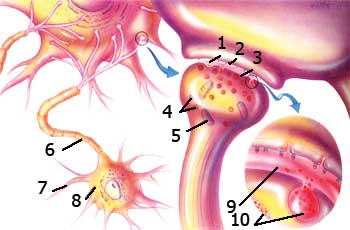 | |
| Right: Acetylcholinesterase enzymes tear into the acetylcholine molecules at great speed, and have been calculated to destroy some 25,000 molecules a second. In other words, an enzyme esterase breaks down an acetylcholine molecule in approximately 40 milliseconds. | 1. Synaptic cleft | 6. Axon |
| Left: In order for the impulse from the sending nerve to reach the receiving nerve, the sending nerve releases a chemical known as acetylcholine into the synaptic gap between the two nerves. Each impulse triggers its own release of acetylcholine. For that reason, the area containing the transmitters must be cleared away before another impulse arrives. The assistants that arrive to perform this action are acetylcholinesterase enzymes. | ||
You can now lift your hand and wave.
Nerves use a system similar to Morse code for communication. But this system consists of dots only. The more important the message, the greater the dot density. Every dot—every nerve impulse, in other words—triggers its own release of acetylcholine. Put another way, the impulse that lets you wave your hand runs along the same nerves that enable you to walk, but each one releases different acetylcholine molecules. For that reason, the region where these transmitters are found has to be cleared before another signal arrives, or otherwise, the messages will become mixed up. For nerves that must sometimes transmit 500 signals a second, this means that numerous acetylcholine transmitters have to be wiped every millisecond.
Acetylcholinesterase enzymes have been created in such a manner that they can do this. These catalysts tear into the acetylcholine molecules at enormous speed. Biochemists have calculated that they destroy 25,000 molecules every second. Viewed from another perspective, each esterase enzyme breaks down an acetylcholine molecule in around 40 milliseconds.83
Many times here, it has been repeated that if even a single enzyme loses its important function, the living organism will start to die, because our lives depend upon these peerless entities so many billions of times smaller than us and their constant activity in our bodies. By itself, acetylcholinesterase is proof of this. Of all the enzymes in the body, if only this enzyme were missing, we could not possibly live, since in a sense, all the electricity in our bodies would be shut off.
 |
| It is We Who give life and cause to die and We are the Inheritor. |
Disorders such as Alzheimer's disease are the result of this enzyme in question failing to function systematically. In that disease, acetylcholine is destroyed more quickly than normal, and thus nerve impulses are either too weak to be received or else not transmitted completely along the nerve cells.84
The intercommunication between 100 billion nerve cells and the nervous network stretching thousands of miles among them is a most marvelous work of Allah. If He so chose, He could of course have created an uninterrupted field with no gaps anywhere on it. The electrical signal could have flowed along the nerves without the need for any chemicals. But this is not how the body works. There is a need for gaps between the nerves, for the chemicals to ensure the transmission between them, and for other chemicals to inhibit these same chemicals. One of the wisest aspects of this is how human beings investigating all this in the laboratory constantly find perfections, miracles and complexities. Allah creates details within details of an extraordinary complexity, and brings them into being dependent on one another.
Here, we are examining the activities of one single component of the system. However, if you remove this small component from the equation, the system will be deprived of all its functions. In other words, only a single enzyme is a critical part of the nervous system. You cannot reduce this mechanism or simplify it. Were it not for this enzyme, the message from your brain would not reach your arm, but become lost in your body. You would be unable even to move your finger, let alone wave at a friend.
These amazing systems you possess are created by Allah. This process is constantly repeated in all your 100 billion nerve cells for the millions of movements you make every day and the countless stimuli from your senses. Allah knows what each one does. Allah protects you and keeps you alive at every moment. All entities are under His control and are submitted to Him.
Allah reminds us of the truth of this in a verse:
 |
| You do not engage in any matter or recite any of the Qur'an or do any action without Our witnessing you while you are occupied with it. Not even the smallest speck eludes your Lord, either on earth or in heaven. Nor is there anything smaller than that, or larger, which is not in a Clear Book. |
The Perfect Enzyme Chain in Blood Clotting
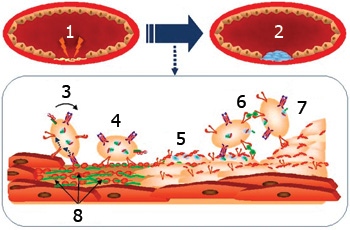 | |
| 1. Injured blood vessel | 5. Spreading |
| The blood clotting system is an extraordinary phenomenon that occurs through the activity of a series of enzymes. Each enzyme must be in the right place and go into action at the right time. Countless enzymes work just as if they knew where they had to be, and when. This perfect cooperation and flawless operation is a blessing created by Allah, and every detail is a manifestation of His might and greatness. | |
The blood-clotting system is an extraordinary phenomenon that operates so flawlessly that when you cut yourself, you can be sure that the flow of blood will soon stop and the injury will seal itself up. That certainty stems from the way the enzymes in your body work in a flawless, systematic manner.
A wound sends the entire body into alarm. The intervention will take place at the site of the cut. When bleeding starts anywhere in the body, all available means are mobilized and flow in the direction of the injury. At this point, certain molecules traveling through the bloodstream suddenly become active, at enormous speed.
First aid is delivered by blood platelets known as thrombocytes. These travel dispersed throughout the bloodstream, so that wherever bleeding may occur, a thrombocyte will always be patrolling nearby.
A protein known as von Willebrand factor works like a policeman calling for backup assistance by indicating the site of an accident. It halts thrombocytes when it detects them and ensures that they remain at the site. The first thrombocyte to arrive signals others by releasing a special substance, just as if it were summoning assistance over the radio.
Once the first intervention has occurred, enzymes take over the work. Up to this point, in fact, a large number of enzymes have already become involved, but we shall concentrate on those that complete the coagulation process. The body always stores inactive enzymes for later use, coding them to go into action only when they receive the signal that their presence is required.
Fibrinogen is a non-active enzyme that travels freely through the body and is found dissolved in blood plasma. It circulates at random until the body suffers a cut anywhere, and then it suddenly goes into action. This protein that serves no function in the plasma heads towards the region of the injury. When a state of alarm develops, another enzyme called thrombin cuts two of the three links in fibrinogen's protein chain, thus converting fibrinogen into fibrin. In other words, a previously non-active enzyme assumes an active role. Small, adhesive parts have now appeared on the injured surface. These allow fibrin to bond to other fibrin molecules. The result is a long chain, and the proteins quickly combine and interlace with one another. This is the primary clot that forms. Subsequently, this fibrin mesh will continue to cover the wound just like a tightly-woven fishing net.
 | |
| A. Clotting enzymes begin working at the site of injury. | |
| 1. Cut | 5. Fibrinogen |
| The enzymes that enable blood clotting literally know what needs to happen when, where they must concentrate, which gap in the body they need to close, and what sequence they need to follow. This immaculate system is too complex for any of its stages to have come about by chance. | |
At the same time, thrombin turns the enzyme factor XIII into factor XIIIa, which strengthens the fibrin clot.85
The thrombin that activates fibrinogen also exists in the blood in an inactive state known as prothrombin. This is vital, because if thrombin constantly coursed through the bloodstream, it would sever all the fibrinogens. Uncontrolled clotting would occur in the body constantly. In order to avoid any such danger, prothrombin too must be activated by another enzyme.
That enzyme, called the Stuart factor, cleaves and activates prothrombin. But what applies to thrombin also applies to Stuart factor. Were it to be moving actively in the blood right from the outset, then in that case, the Stuart factor would constantly initiate the clotting mechanism and uncontrolled clotting would also begin. For that reason, Stuart factor also exists in an active state while circulating in the blood.
However, Stuart factor by itself is not enough for prothrombin to be set into action. Still another enzyme, accelerin, works with it to convert prothrombin into thrombin.
We might therefore assume that accelerin is also initially not in an active state. However, its activation system involves a puzzle reminiscent of the riddle of "the chicken and the egg"—because it is thrombin that activates accelerin! How do we explain the fact that accelerin is activated by the very enzyme that it itself activates?
The reason is that Stuart factor cleaves the prothrombin at a very low rate. The result is that as a precautionary measure, a certain amount of thrombin is always ready in the body. The whole phenomenon begins with this significant precaution and as the Stuart factor goes into action, the clotting system also goes into action at high speed.
This system of various factors enables blood clotting to take place. The enzymes must know which have to go into action when, where they need to concentrate, and what gap in the body they have to cover over. They also need to know when to stop their work. If the clotting process that begins over a wound does not stop at the proper stage, this will constitute a serious danger for the body. Uncontrolled clotting will mean blood vessel congestion, and vital organs will fail to function. It is therefore essential to halt the activities of these enzymes that consecutively activate one another. Yet other enzymes inform them of this.
Once the wound has healed, the blood clot also needs to be removed. The molecules that arrive on the scene for this task are, again, enzymes. The one known as plasmin works like a pair of scissors to cut the fibrin clots. Plasmin works on fibrin, but not on fibrinogen, the latter's inactive state. Were that not so, it would cause a serious difficulty for future clotting. Plasmin cannot act too quickly, which is actually an advantage: Otherwise, the wound would not heal before plasmin, which is activated when the wound appears, had severed the fibrin, breaking down clots as soon as they formed.
There are numerous other enzymes involved in the blood clotting system. Each is necessary to carry out or complete a particular process, and all are parts of an irreducibly complex system from which not a single component can be removed.
 |
| Were it not for the blood-clotting system, we would be defenseless against all kinds of injuries to our bodies. Beginning in infancy, the smallest cut would lead to a severe loss of blood. Yet through the mercy of Allah and by means of the clotting system we possess, we are under constant protection. |
The author James Perloff was once a dyedin-the-wool atheist, but now advocates the fact of creation against evolution. He adds to Michael Behe's comments regarding the dilemma facing evolutionists with regard to the blood-clotting system:
The formation of a blood clot is a complex, multi-step process that utilizes numerous proteins, many with no other function besides clotting. Each protein depends on an enzyme to activate it. So to paraphrase Behe very simply: What evolved first—the protein or enzyme? Not the protein; it cannot function without the enzyme to switch it on. But why would nature evolve the activating enzyme first? Without the protein, it serves no purpose. Furthermore, if blood clotting had evolved step-by-step over eons, creatures would have bled to death before it was ever perfected. The system is irreducibly complex.86
Could any system that consists of hundreds of stages, not one of which can be simplified or removed, have formed as the result of unconscious molecules joining together by chance? Can unconscious atoms accidently give rise to one enzyme belonging to the blood-clotting system? Can coincidences work miracles? Can chance create something out of nothing?
None of these are possible, of course. Evolutionists maintain that blind coincidences created out of unconscious atoms a clotting system that behaves in a literally conscious manner. Chance is the false deity of Darwinism, that supposedly works miracles. That is why evolutionists seek to convince others that chance produces new species, works miracles and creates something out of nothing.
The fact is, however, that it is impossible for perfect, regular systems to emerge as a result of random, uncontrolled and unconscious phenomena. Any random event in a mechanism as complex and detailed as the blood-clotting system, so sensitive at the molecular level and requiring a complex division of tasks, will turn that whole procedure upside down. Like all the other systems in the human body, this system demonstrates the might and greatness of Allah.
Allah is the Creator of all things and all things are obedient to Him:
That is Allah, your Lord. There is no deity but Him, the Creator of everything. So worship Him. He is responsible for everything. Eyesight cannot perceive Him but He perceives eyesight. He is the All-Penetrating, the All-Aware. (Surat al-An'am: 102-103)
Lysosomal Enzymes
 | ||
| 1. Active site | 2. Sugar | 3. Active site |
| The breaking down of the bacterial cell membrane by the active site of the lysosomal enzyme A shows the tertiary structure of the lysosomal enzyme. B and C designate the active site in the protein. The sugar substrate binds to the active site together with the bacterial cell membrane. Lysosomal enzymes break the bonds between the two sugar molecules, letting the bacterial cell membrane to be torn apart. Thus the bacterium dies. | ||
One of the organelles that exhibit intense activity within the cell is the lysosome. Each lysosome is about 0.5 microns in diameter (1 micron = 1/1,000 millimeters). They contain various degradative enzymes. Thanks to these enzymes, a great many eliminatory processes are performed in the body.
The lysosome is the cells' grinder. Lysosome enzymes tear apart, break down and destroy cells no longer of any use in the body. Bacteria, virus and cell fragments, dead tissues and large, harmful particles are all eliminated as the result of the activities of these enzymes, leaving behind useful parts that the body can recycle. For example, the dark area that occurs when you bruise your skin is the remains of the dead cells in that area. The region soon heals and returns to its former state, thanks to the lysosomal enzymes breaking down and getting rid of dead tissues.
Thirty-six different enzymes serve in the lysosome. These enzymes open a hole in the membrane surrounding a structure and halt the body's constantly multiplying cells by breaking them down. This is exceedingly important, because if this process did not take place, cells in the body would keep on multiplying, leading to organ growth and the constant formation of tumors throughout the body.
Since these degradative duties are vital to the body's defense system, these enzymes are generally found in leukocytes and macrophages, which are able to ingest bacteria and other foreign materials they encounter within the body by way of phagocytosis. (For more on phagocytosis, see Harun Yahya, The Miracle of the Immune System, [New Delhi: Goodword Books, 2001].)
Lysosomal enzymes are highly efficient at breaking down substances. Inside the lysosome, however, they are in an inactive state. If the lysosome membrane is pierced or torn, the enzymes begin destroying the cell they are in, a process known as autolysis. This destruction generally takes place on old or damaged organelles or ones that are no longer functioning. The lysosome inside every cell performs this process through the enzymes it releases, eliminates dead organelles, and sometimes completely destroys the cell itself.
For example, a large number of bacteria enter your body along with the food you eat. The duty of destroying these while they are still in the mouth lies with the lysosomal enzymes. At the same time, these enzymes ingest and clear up food wastes remaining in the mouth, thus eliminating the food that can support bacteria. In this way, bacteria are condemned to death by starvation.
Lysosomal enzymes serve again and again at different times in very different regions of the body. During pregnancy, the growth of the womb is a result of cell multiplication. This ability while the baby is still developing is a life-saving and miraculous development. However, this cell multiplication needs to come to an end after birth, and the body must return to its former state—which is where lysosomal enzymes come in. The lysosomes of specific cells are alerted and start manufacturing enzymes, as if they literally knew what they need to do. Then over the next 10 days, they carry out a large process of destruction, resulting in a 40-fold reduction in the size of the mother's womb.
The destructive effects of lysosomal enzymes are also required for fertilization. When the sperm cell reaches the ovum, it employs the destructive lysosomal enzymes it carries with it to pierce the sheath surrounding the egg. Thanks to these enzymes, the sperm can enter and fertilize the egg.
Since all the processes in the body occur at the molecular level, perhaps you may never have imagined that the body could also contain waste products. In fact, however, cells are constantly dying as the human body renews itself and in its constant fight against bacteria and viruses—and waste products are constantly emerging. If allowed to accumulate, these might cause poisoning of cells, congestion in the bloodstream, and organs to cease operation. The lysosomal enzymes in the body serve as a precaution against this.
Like all the other parts of the human body they behave very rationally, never intervening against healthy structures. They immediately identify the wastes that need to be eliminated and act to keep the body alive. They act as to the command and will of Allah. Unless Allah so wishes, no other power can do what they do or produce anything like them.
Allah is Magnificent and Almighty, and His artistry enfolds all places. This is revealed in a verse:
Allah, there is no deity but Him, the Living, the Self-Sustaining. He is not subject to drowsiness or sleep. Everything in the heavens and the earth belongs to Him. Who can intercede with Him except by His permission? He knows what is before them and what is behind them, but they cannot grasp any of His knowledge save what He wills. His Footstool encompasses the heavens and the earth and their preservation does not tire Him. He is the Most High, the Magnificent. (Surat al-Baqara: 255)
Enzyme Inhibitors
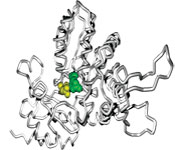 |
| Inhibitors inactivate enzymes by binding to them. Reactions that need to be halted, and drugs that inhibit enzymes that cause diseases, both act by way of enzyme inhibitors. |
Enzymes are constantly active within the body. As a result of communication between organelles, these proteins know when they must go into action and operate non-stop. Sometimes, however, their activities must be halted or prevented. When the reactions in progress reach a sufficient level to meet the cell's requirements—in other words, when the intervention performed by enzymes is completed—the body has a system to bring all their activities to an end. This really magnificent control system is carried out by other proteins known as enzyme inhibitors.
Inhibitors inactivate an enzyme by binding to it. The binding of an inhibitor is either reversible or irreversible. Irreversible inhibitors bind covalently and change the enzyme chemically. Reversible inhibitors, however, bind to enzymes non-covalently. There are two types of reversible inhibitors: competitive and non-competitive inhibitors.
A competitive inhibitor blocks the active site of an enzyme. The inhibitor is similar in structure to the real substrate and the enzyme binds to the inhibitor rather than to its intended substrate. The enzyme's active site is thus closed off in such a way as to prevent its binding to the substrate at the same time.
A non-competitive inhibitor binds to a different site on an enzyme, other than the active site. This neutralizes the enzyme because inhibitor binding changes the enzyme's tertiary structure and the substrate's affinity for the active site is reduced. However, non-competitive inhibitors do not eliminate all of an enzyme's activity; they only decrease it.
Penicillin is an excellent example of this. By inhibiting the enzymes that bacteria need to make their cell walls, it causes the bacteria to burst.87
Various drugs have been manufactured according to the enzyme-inhibition system. These drugs work by inhibiting the action of enzymes that bacteria or viruses need, prevent them from spreading, and thus prevent many diseases from becoming any worse. In treatments for HIV, the most successful developments to date are the result of the use of enzyme inhibitors.88 Some cancers can also be prevented by identifying the enzymes that benefit them and developing the appropriate inhibitors.
Apart from surgery, all fields of medicine are in some way related to enzymes. Dr. Joseph Kraut, who works on models of enzymes magnified 200 million times, summarizes this:
Did you take an aspirin? You may bet that aspirin molecules will go and stimulate an enzyme. This will accelerate or slow down the work of an enzyme and guess what happens next. How quickly! Your headache has already gone.89
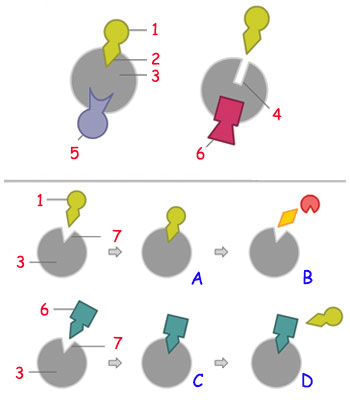 | 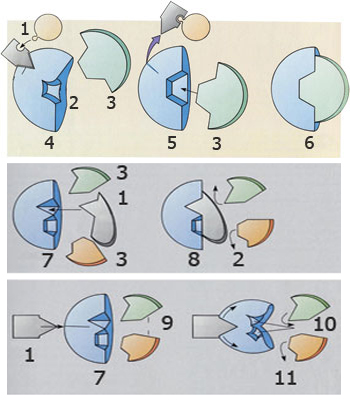 | ||
| 1. Substrate | 5. Enzyme activator | 1. Inhibitor | 5. Active form of the enzyme |
| A. A reaction takes place, and a product emerges. | 8. Enzyme inhibitor binds to the active site. | ||
| Enzyme inhibitors seem to know when to put a halt to which reactions. They imitate the shape of the substrate necessary for the particular reaction and bind to the enzyme's active site. The binding of the substrate to the enzyme is thus prevented. | Blood clotting, as with many other reactions such as DNA replication, needs to be halted once the process is complete. Enzyme inhibitors proceed to the site and inactivate the enzymes. | ||
Enzyme-inhibitor molecules must exist in the same environment as enzymes, because under certain circumstances, the way they put a halt to enzymatic activity can be vital. For example, the activity of enzymes must be brought to an end at a certain point in such processes as DNA replication or blood clotting. If an enzyme is always setting the blood-clotting system in motion, this will lead to clots constantly. Then blood flow will be impeded, and the organism will die—if not for enzyme inhibitors.
So how do evolutionists, who are not even able to account for the enzymes' existence, account for this? Even if we do assume that a single enzyme did come into being by chance, then enzyme inhibitors must absolutely have come into existence by chance at that same moment. It's absurd for an enzyme to form, then to wait millions of years for a substance that will inhibit it to come into being by chance. In such a scenario, the enzyme would keep on working actively, and the organism would soon die. It is impossible for an organism with enzymes to stay alive in the absence of enzyme inhibitors—and of course, enzyme inhibitors have no significance in the absence of enzymes. Moreover, even if enzymes exist, there must still be some control mechanism to let the inhibitors reduce their activity. Without it, enzyme inhibitors would immediately block all enzymes, and there would be no point in enzymes emerging at all.
David and Kenneth Rodabaugh from the Creation Research Society make the following statement:
It is clear that enzymes were not present in the primordial soup. Even if they were formed, they would not have lasted long since the primeval soup was, by definition, a conglomeration of nearly every conceivable chemical substance. There would have been innumerable enzyme inhibitors present to inhibit an enzyme as soon as it appeared. Thus, such molecules could not have formed; however, even with the assumption that they had formed, they could not have remained.90
Our bodies' control mechanism ensures a sufficient number of enzymes and of enzyme inhibitors responsible for inhibiting them, and regulates their production and operation. None of these ever goes beyond its own duties. Inhibitors never decide to halt the activity of enzymes on their own; and enzymes never ignore them and thus have an unbalancing effect on the production and operation. The reason is that all the supervision that goes on in the body belongs to Allah. Every enzyme is a miracle created by Allah; every enzyme inhibitor is a blessing created by Him. Each of these molecules, the mechanisms that control them, the structures they work alongside, and the special three-dimensional shapes they possess all exist because Allah so wills it—and what Allah wills, He carries out to perfection.
| He has given you everything you have asked Him for. If you tried to number Allah's blessings, you could never count them. Man is indeed wrongdoing, ungrateful. |
 |
| Everything in the heavens and every creature on the earth prostrates to Allah, |
Footnotes
83 http://www.tuberose.com/Enzymes.html
84 http://www.supplementwatch.com/supatoz/supplement.asp?supplementId=309
85 Harper'ın Biyokimyası (Harper's Biochemistry), Robert K. Murray, Peter A. Mayes, Darly K. Granner, Victor W. Rodwell, Barış Kitabevi, 1993, p. 783
86 James Perloff, "The case against Darwin," February 20, 2001, http://www.worldnetdaily.com/news/article.asp?ARTICLE_ID=21776
87 "How Enzymes Work," http://www.biologycorner.com/bio3/notes-enzymes.html
88 "Enzymes as Biological Catalysts," http://www.chemistry.wustl.edu/~edudev/LabTutorials/HIV
/DrugStrategies.html#Enzymes
89 Bilim ve Teknik (Science and Technique), Tubitak Yayınları, May 1972, Volume 54, p. 6
90 David and Kenneth Rodabaugh, Creation Research Society Quarterly, December 1990, p. 107; http://www.pathlights.com/ce_encyclopedia/Encyclopedia/07prim04.htm
